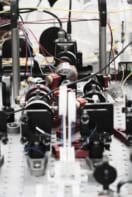Researchers from the National Institute for Standards and Technology (NIST) in the US have built an optical clock that promises to be the world’s most accurate. The clock is accurate to one part in 10-17, which means it cannot lose or gain a second in more than one billion years.
Optical clocks provide us with the most accurate time keeping known. Unlike conventional atomic clocks, which use microwave radiation, an optical clock uses a beam of visible laser light to fire at an ion. The frequency of the light is tuned so that the ion can absorb a photon and jump from a lower to a higher energy state. When the photon is emitted a moment later the ion returns to lower energy state, much like the ticking of a clock. The jumping is so fast that in one second it can occur over 9 billion times.
Till Rosenband and colleagues selected a single aluminium ion as the basis for their clock because aluminium is less sensitive to temperature and electric fields than mercury, the ion used for the present most accurate clock. But there is a catch: the transition from the ground to excited state in aluminium is hard to probe directly with light. The researchers, therefore, held a beryllium ion next to the aluminium ion in a trap, so that the aluminium ion’s internal state could be transferred to the beryllium ion. This internal state could then be measured — a technique known as quantum logic spectroscopy (Science Express doi: 10.1126/science.1154622).
Apart from the potential of allowing GPS satellites to track position with sub-metre precision, the improved accuracy of the optical clock has led the researchers at NIST to look at whether the fine-structure constant, which governs how light and electrons interact, has actually been changing over time. By measuring the ratio of clock frequencies for aluminium and mercury the researchers at NIST have concluded that the fine structure constant is not changing to within 1.6 x 10-17 per year. Indeed, they believe they have met the required precision to say that it is not changing at all. “This measurement of the ratio of aluminium and mercury clock frequencies is the most accurate known physical constant,” says Rosenband.
The NIST researchers believe that aluminium could be a potential candidate for a clock that is accurate to 1 part in a billionth of a billionth (1 x 1018) of a second, even more accurate than mercury. This would allow researchers to further tighten the constraints on whether the fine structure constant is changing.


